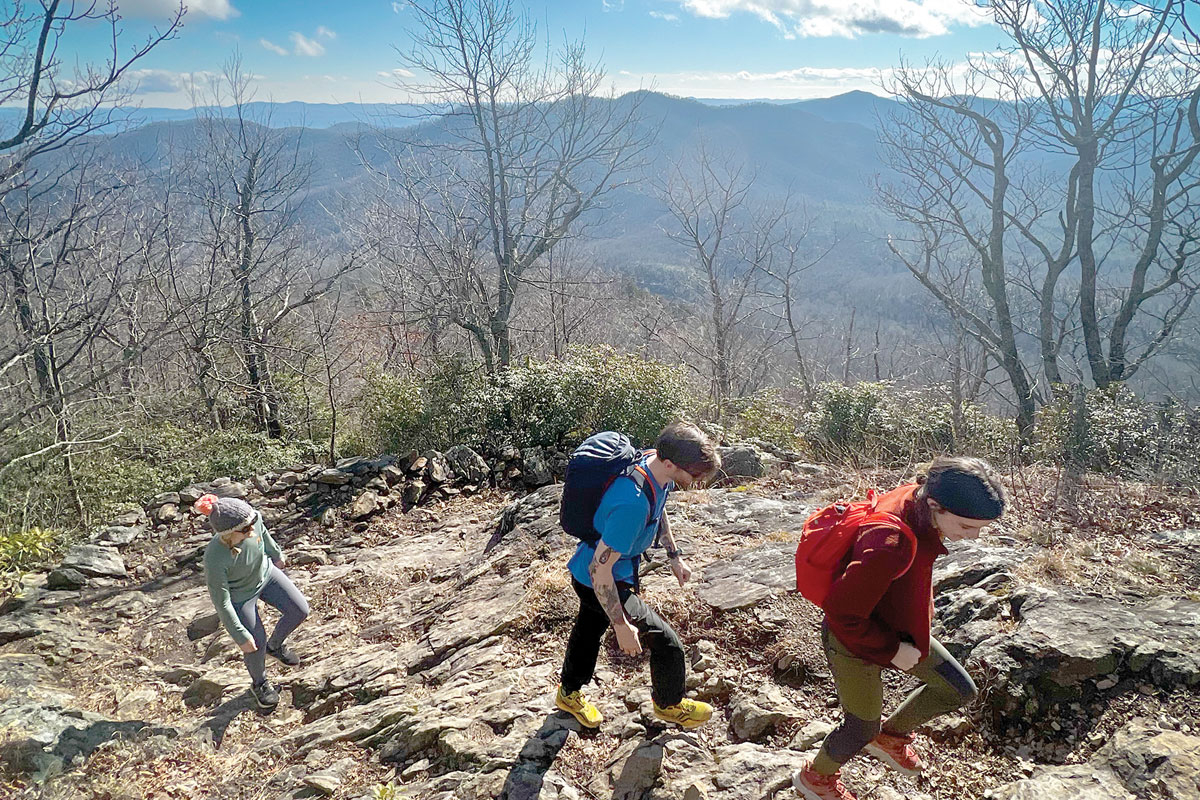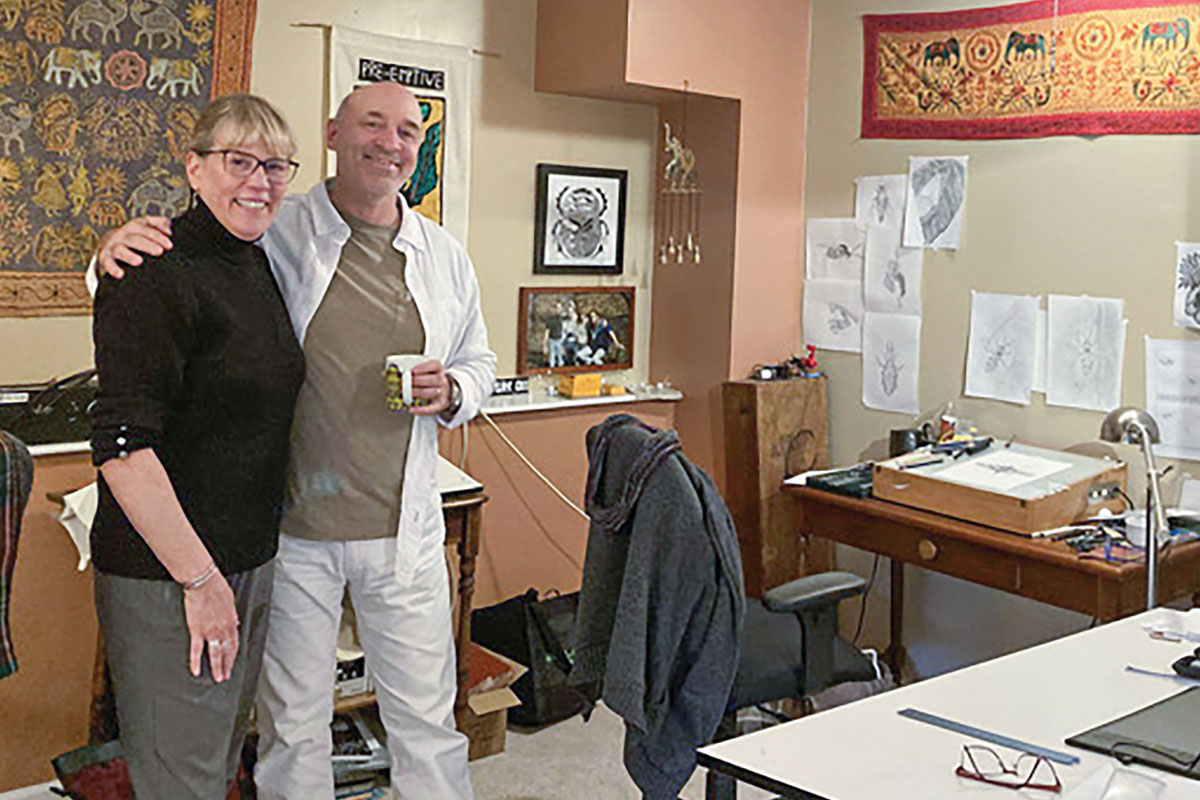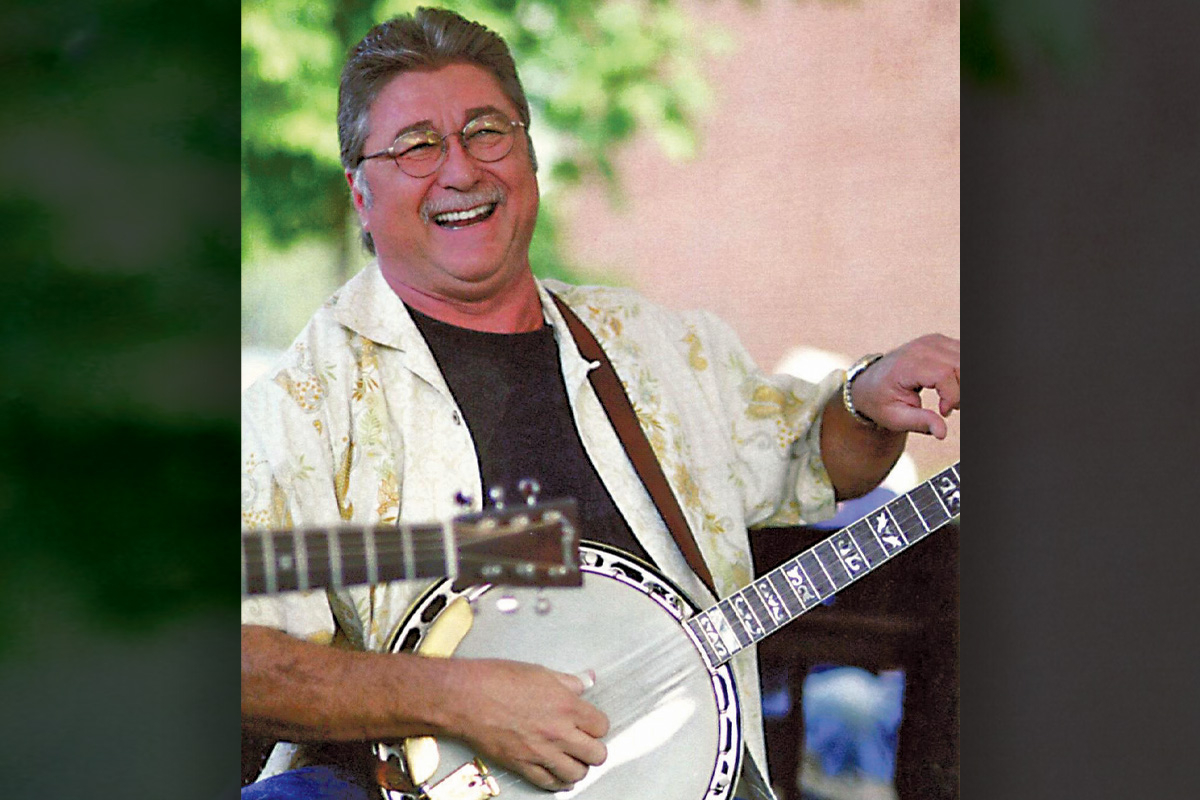Admin
The N.C. Cooperative Extension’s Good Cooks Series will continue with a Native American flair at 2 p.m. on Friday, Feb. 11, in the Conference Room of the Community Service Center in Sylva.
Jennifer Siweumptewa, an assistant in the Culinary Arts Department at Southwestern Community College, will demonstrate the art of making Indian fry bread.
Fry bread is a specialty of many Southwest Indians tribes (mainly Navajo and Hopi) and is often enjoyed with savory foods or drizzled with honey and enjoyed as a sweet.
Cost for the class is $5. 828.586.4009 to register.
The DAYDREAMZ project and Kids at Work, two local non-profit organizations, are offering an afternoon of community baking and creating sweet treats for underprivileged.
“heART,” a community baking event will be held from 4 to 6 p.m. on Feb. 10 at the Open Door Kitchen/ at 32 Commerce St. in Frog Level.
Bring rolling pins, cookie cutters, cookie sheets, baking pans, measuring cups and spoons (to use while we bake) and friends and family members.
Ingredients needed, if you can spare, are flour (unbleached if possible), sugar (white, brown and powdered), eggs, oil and butter (only the real thing), cream, chocolate chips and bakers chocolate (semi-sweet), rice crispies cereal, marshmallow or fluff, cookie decorations (sprinkles and such).
The purpose is to have fun and make and bake sweet treats for local seniors, the homeless, and others in need to remind them they too are cared about on Valentine’s Day. For more information or to donate ingredients or funds call 828.456.3952 or 828.454.5165.
A new exhibit featuring research and displays developed by the Appalachian Women’s Museum in Dillsboro is now open for public viewing at Western Carolina University’s Mountain Heritage Center.
The exhibit addresses topics such as the evolution of canning technology, the community legacy of Edna and Edith Monteith of Dillsboro, and the accomplishments of notable Jackson County women such as famed traditional musician Samantha Biddix Baumgarner and pioneer political figure Gertrude Dills McKee. Exhibit topics have been enhanced with images and artifacts from the Mountain Heritage Center, the office of Special Collections of WCU’s Hunter Library, and family members of the individuals featured.
The exhibit will remain on display at the Mountain Heritage Center through Wednesday, June 8.
Located on the ground floor of H.F. Robinson Administration Building, the center is open 8 a.m. to 5 p.m. weekdays (and until 8 p.m. Thursdays) and from 10 a.m. to 5 p.m. on Saturdays, June through October.
For more information, call the Mountain Heritage Center at 828.227.7129 or visit www.wcu.edu/mhc.
By DeeAnna Haney • SMN Intern
All it took was a knack for guitar playing and a single visit to Nashville, Tenn., to spur a lifelong passion in one Tuscola High School senior’s life.
Singer/songwriter MacKenzie Leigh Wilson recently released her first extended play record in January featuring four original songs. With rhythms as bouncy and lively as her personality, the record is just a small taste of what Wilson has to offer.
The young musician moved to Western North Carolina from Charlotte two years ago when her father Chuck Wilson, a minister, transferred to Long’s Chapel United Methodist Church.
Although Wilson describes a childhood full of singing in church and community choirs, she admits she never considered pursuing it as a career. But a family vacation to Nashville for her 16th birthday ignited inspiration to try her hand at songwriting.
Since her fateful visit to Nashville, Wilson has written more than 60 songs.
“My mind is constantly spinning with new song ideas,” Wilson said. “That’s what I love so much about songwriting, you can write anywhere, anytime.”
She often writes songs when inspiration hits, and will sometimes not write for weeks at a time, she said. Other times, she may write multiple songs in one week. One thing is certain — she writes best when alone without distractions.
Even though Wilson started playing guitar at age 15, she didn’t find a true love for the instrument until she started writing her own material. Her guitar instructor, Larry Watson, was immediately impressed by Wilson’s raw talent and dedication to her music.
When it came to “teaching,” Watson only provided a little guidance on music theory and chord progressions.
“When you take someone like MacKenzie who’s already talented, you don’t have to do a whole lot because they grab it really quick,” Watson said.
Taking her talent to the stage, Wilson has performed locally, is a member of Summit choral group at Tuscola High School and won the local talent competition “Haywood Idol” in 2009.
But you won’t catch Wilson performing many covers of other musicians. While she admires and draws inspiration from many famous names — including Michelle Branch, Sara Bareilles, and Loretta Lynn — Wilson seeks to set her writing style and vocals apart from others.
“There’s something about when you’re playing your own songs and when you’re singing your own song, it’s just so different than just covering someone else’s,” Wilson said.
With an evident country twang and soulful, upbeat melodies, Wilson’s overall musical style is a country-pop hybrid sound akin to a mix of traditional Patsy Cline and contemporary LeAnn Rimes. She also draws inspiration from folk, bluegrass and classic rock to create her unique sound.
Wilson’s songs typically aim to reflect who she is as a person and where she is in life, with themes of young love, heartache and growing up.
“I am much more honest with my music than I am in real life — it’s much easier for me to put things in a song than it is to just sit down and talk to someone,” Wilson said
With the help of Watson, Wilson decided to explore creating an extended play record at Crossroads Records in Arden. Known mainly for bluegrass recordings, Crossroads Records has produced albums for such popular artists as the Kingdom Heirs, The McKameys and The Greenes.
Having never spent time in a studio, Wilson had no idea what to expect of the project and began knowing only which four original songs she wanted to record.
Wilson first recorded a base track with raw vocals and guitar, then the studio band built on the original to complete the sound. She went back and added her own harmonies.
The four songs range from ballads to energetic country, offering a balanced sound each with strong commercial appeal. The most popular so far, Wilson said, is “She Plays You,” a fresh take on the story of the girl who wants to be noticed.
“I kinda say that that’s like my anthem because I’m the girl who goes home and plays guitar, not the girl who is out chasing boys,” Wilson said.
And just like the lyrics from her slower, more emotional song, “Tennessee,” Wilson says, “Carolina’s in my heart but it’s time for a new start.” She plans to attend Belmont University in Nashville in the fall of 2011 and hopes to major in songwriting. She wants to take piano and mandolin classes while she is there.
But Wilson’s main goal in Nashville is not to achieve fame and fortune. Instead, she is most excited about being able to interact and work with fellow songwriters and hopes to learn new techniques and become stronger in her craft.
Of her future, Watson predicts great success.
“She is an extremely talented person and no one person could take the credit for anything she’s done,” Watson said. “I was just fortunate enough to get to help her.”
Wilson believes in the importance of having an identity as an artist and hopes to gain more sense of her own as she continues to write, perform, record and evolve. In the meantime, she intends to finish her senior year and enjoy being a high school student.
“I’m just like every other high school girl out there, I’m just the girl who goes home every day and writes songs about it,” Wilson said. “I want to stay that girl.”
In the hunt for an informal camping club with no annual dues and no actual meetings except for actually going to campouts? Check out the Vagabonds, which is now seeking new members.
While there are no planned activities, members do sometimes get together to play cards or games or horseshoes. And they share a love of the outdoors, good conversation, fellowship and roaring campfires.
A schedule for upcoming campouts for the second weekend of each month, March through November, is being compiled now. For March, the group is looking for a campground out of the mountain area that has an indoor room for use by the group. Otherwise, campgrounds chosen are generally within 100 miles of Franklin, in states bordering North Carolina.
Each participant receives a camping schedule and makes their respective reservations.
828.369.6669 or This email address is being protected from spambots. You need JavaScript enabled to view it..
The U.S. Forest Service is distributing free copies of a new guide, titled “A Management Guide for Invasive Plants in Southern Forests,” that gives homeowners, gardeners, land managers and others information on controlling and removing invasive plants in the South.
“The guide provides the latest information on how to create and carry out prevention programs, implement management practices, and rehabilitate and restore land,” said Jim Miller, an emeritus Southern Research Station research ecologist based in Auburn, Ala., and lead author of the book. “The guide serves as a staple for foresters, natural resource managers and others who want to remove invasive plants that have become a serious problem in the 13 southern states.”
Invasive plants often harm forests and other natural areas by pushing out native plants, which degrades habitat and adversely affects wildlife. Exotic plants often reduce forest productivity, native plant and animal diversity, and water quality and quantity.
Get free copies of “A Management Guide for Invasive Plants in Southern Forests” by sending your name and complete mailing address, along with book title, author and publication number GTR-SRS-131 to: This email address is being protected from spambots. You need JavaScript enabled to view it. or 828.257.4830.
Runners can register now for one of Western North Carolina’s most storied summer road races.
Registration for the Maggie Valley Moonlight Race opened this Feb. 1, and continues through race day, Saturday, Aug. 27. The fee to participate in this 8K race is $25 through July 30 and $30 during August.
“After a two-year absence, Glory Hound Events is proud to bring the Moonlight Race back to the Western North Carolina running scene,” Greg Duff, race organizer, said. “Runners should be pleased to know that we are planning to restore some of the traditions of the past, as well as incorporate some modern aspects for the 30th running.”
The Maggie Valley Chamber of Commerce will host the evening race, which starts at the Maggie Valley Fairgrounds and uses the same course as in 2008.
That course takes runners 1.2 miles up the valley to Ghost Town, then 2.4 miles in the opposite direction, before returning them 1.2 miles to the finish line back at the fairgrounds.
Major sponsors for the returning Moonlight Race to date include Mission Health Systems and The Smoky Mountain News. All event information, including a link to online registration, is available at www.maggievalleymoonlightrun.com.
Wild South, a regional nonprofit that works to restore the South’s natural landscapes, wants help on accessing wildlife resources.
An online survey has been set up at: www.wildsouth.org/index.php/component/content/article/3-newsflash/400-wildlife-survey.
Wild South says concerns regarding wildlife resources have arisen, including: illegal activities, human/wildlife conflicts, habitat loss and habitat management. The purpose of the WNC Wildlife Advocates’ survey through Wild South is to seek solutions to protect the region’s wildlife, and educate the public on responsible behaviors that minimize conflicts. The survey is designed to identify priorities for action and to explore potential solutions that the group will champion in the future.
The Swain County Cooperative Extension is now taking orders for 3- to 4-foot apple, pear and peach trees, along with three-year old blueberry and two-year old grape varieties.
Prices are $12 for the apple, pear and peach trees and $8 for the grapes and blueberries. All plant material will arrive bare-rooted.
Money raised will be put into the Swain County 4-H Fund for local youth scholarships.
Mail completed order form and payment to: Swain County 4-H Fund, PO Box 2329, Bryson City, N.C., 28713
All orders and checks must be received by Wednesday, Feb. 9. The shipment will arrive at the Swain office on Wednesday, March 2.
828.488.3848.
The Commissioners of the N.C. Wildlife Resources Commission unanimously adopted a resolution recently reaffirming the agency’s longstanding support for hunting with the use of dogs.
“We support the use of dogs in hunting in North Carolina where such hunting is consistent with the sound conservation of our state’s treasured wildlife resources and not contrary to the protection of the private property rights of its citizens,” said Gordon Myers, executive director of the commission. “Hunting with dogs is part of a centuries old tradition in North Carolina and the members of the Wildlife Resources Commission determined that it was important to clarify their position regarding those practices.”
The partnership of hunters and hunting dogs, commissioners affirmed, has long been a central thread of North Carolina hunting culture, and thousands of hunters – young and old – use dogs to pursue grouse and quail, waterfowl and woodcock, deer and bear, rabbits and squirrels, and foxes and bobcats, and raccoons and opossums.
“The members of the Wildlife Resources Commission looks forward to continuing its successful record of working with multiple partners to provide opportunities for hunters to use dogs on state and private lands where feasible and appropriate,” said Commission Chairman Steve Windham.
For more information on hunting in North Carolina or for a copy of the resolution, visit www.ncwildlife.org.
The Sylva Community Garden project is seeking new members to join for the upcoming season. Plots of 15-feet by 30-feet are available for free in downtown Sylva. Gardeners participating must agree to donate at least one-half of the produce grown to The Community Table in Sylva (or others in need), providing fresh, local, organic produce to help feed members of the community. Tools, mulch, compost and water are provided to all gardeners. Contact Ann Tiner at This email address is being protected from spambots. You need JavaScript enabled to view it., or 828.226.1885 for additional information and an application. Or, search for search for The Sylva Community Garden on Facebook.
Also, there is space in the community garden at the Monteith Farmstead in Dillsboro. Plots are available for a $20 fee. Contact Ron Arps at 828.586.5478 or This email address is being protected from spambots. You need JavaScript enabled to view it..
Local author Ron Rash will hold a reading at City Lights in Sylva to celebrate the paperback release of his short story collection, Burning Bright, at 2 p.m. on Sunday, Feb. 13
Rash teaches writing at WCU and is an award-winning author of several celebrated novels including Serena and The World Made Straight. He will launch the paperback edition of Burning Bright with this appearance at City Lights.
Signed copies can be reserved for those unable to attend. 828.586.9499
To the Editor:
Recently the National Science Foundation (NSF) granted Professor Thomas Ford (WCU) and Associate Professor Julie Woodzicka (Washington and Lee University) $300,000.00 to research how sexist humor contributes to imbalanced relations between men and women. Naturally it’s assumed that men have the sexist attitudes and women are the victims of it. The participants in this project will perform such tasks necessary to help the researchers determine how exposure to sexist humor affects perceptions of women and discrimination against them.
The NSF was established by Congress in 1950 with an initial allocation of $225,000. and a “strict budget cap” of $15 million. Like all government agencies, it’s grown over these 60 years and its bloated budget is now in the billions, $6.78 billion in 2010, to be exact. Yes, these are our tax dollars.
We in America live under an overpowering double standard in respect to sexism. I’m fond of the abstract analogy that if a man stands naked in a window and a woman sees him, he’ll be arrested for indecent exposure. If a woman stands naked in a window and a man sees her, he’ll be arrested for being a “Peeping Tom.”
Discrimination, prejudice, bigotry, racism, sexism, narrow-mindedness, all exist in our society. It’s unfortunate but none-the-less, they’re part of the human condition.
David L. Snell
Dillsboro
To the Editor:
Fox News seems to be playing in public places all over Haywood County — restaurants, bars, even the lobby of my favorite fitness center. I am troubled that the divisive message of Fox News is further polarizing our country at a time we all need to be pulling together.
The largest shareholder of News Corporation, the parent of Fox, is Rupert Murdoch, an Australian. The second largest shareholder is Prince Alwaleed bin Talal al-Saud of Saudi Arabia. I do not believe that these owners are acting in the best interests of America.
All the 24-hour cable news networks jump on controversy to increase ratings, but the others are not as one-sided as Fox. It seems to me that Fox creates controversy by pitting groups of people against one another — white against black, US-born against immigrant, Christian against Muslim, gay against straight, Republican against Democrat.
Some of their hosts spout irresponsible anti-government speech, which can and has incited unstable viewers to violence.
There is no question that Fox News has a right to broadcast what they do. The First Amendment protects us all from government efforts to suppress speech. But consumers, businesses, and other establishments can and should decide whether or not they want to be a part of what Fox is doing.
Why not air the Weather Channel in public places? This would be a non-controversial public service and not provide a vehicle for attempts to divide America, except for warm versus cold and snow versus sun.
Carole Larivee
Waynesville
To the Editor:
As usual, your paper continues to cover important issues of our area that others largely ignore, but I feel I must call attention to a recent blunder.
After seeing your front page titled “Room to Row,”(SMN cover, Jan. 26 issue) I had to let out an audible groan. As one of the few rowers west of Asheville, I’ve found myself (more than a few times) having to explain the difference between rowing and kayaking. One does not ROW a kayak, canoe or raft; they are PADDLED. A rower propels a boat backward using oars, not a paddle. Also, a row boat needs flat water, such as a lake or deep river.
Although I can appreciate the play on words the title was obviously meant to be, it only adds to the misconception that many people have about the often misunderstood sport of rowing! If any of your readers would like to know more about rowing, I would recommend www.usrowing.org as a starting place.
Bruce Buchanan
Sylva
To the Editor:
The title of Scott Muirhead’s op-ed on Frog Level (“A place where two worlds collide,” The Smoky Mountain News, Jan. 25) lures us with a deceptively disingenuous, “A place where two worlds collide head on.” Search as we might, his casually crafted narrative loses focus; and as a consequence, he fails to establish any collision whatsoever. But he has opinion to express, so let’s forgive him his elusive title and move on.
As we do, we discover the world of “the winos and the junkies and the ne’er-do-wells.” Joining them in their world is the “waver” for whom Muirhead dismissively opines that “most people would feel sorry for the waver, thinking him deprived, I don’t.”
The only collision here is between Muirhead’s openly declared values and what he undocumentedly infers to be those of “most other people.”
His noble justification for such callous disregard is that while the waver is “going nowhere,” Muirhead is “headed to the courthouse to pay another tax on my little bundle of burdens” or to some “insurance agency” or “bank” to make a deposit.
Muirhead then suggests that he must bear the burden of “Worry and Stress” while inferring that Frog Level’s citizens have immunity from any such burdens.
Finally, like Napoleon, who beckoned the Pope only to make him stand aside while he crowned himself Emperor, Muirhead distinguishes himself from Frog Level’s denizens by declaring that he and most of us are “enlightened and aware and playing by all the rules.” Speak for yourself, Muirhead; for you speak not for me!
Tom Ezell
Waynesville
Editor’s note: For the record, the headline for Muirhead’s article last week was written by editors, not Muirhead.
The one-woman show “The Last Flapper” comes to Waynesville’s HART Studio this month, portraying the life of Zelda Fitzgerald.
Fitzgerald, wife of author F. Scott Fitzgerald, spent the final years of her life in Asheville’s Highland Mental Hospital. She died in a fire that swept through the facility in 1948. During the early years of her stay, her husband would come to visit and stay at the Grove Park Inn.
The play is based on her writings and was created by playwright William Luce in 1987.
Performances will run at 7:30 p.m. Friday and Saturday, Feb. 4 and 5, and at 3 p.m. on Sunday, Feb. 6. Tickets are $8 for all adults and $5 for students.
828.456 6322.
Auditions will be held for “Shipwrecked,” the latest production of the Haywood Arts Regional Theatre, at 6:30 p.m. on Sunday and Monday, Feb. 6 and 7, in Waynesville’s Performing Arts Center at the Shelton House.
The show is based on a true story and the small ensemble will create a 19th century world on land and sea on a mostly bare stage.
Anyone interested in working on stage in the cast, as part of the crew or assisting in any way is encouraged to stop by during the auditions. The show will run April 1-10.
Free knitting classes for both children and adults are ramping up at the Waynesville Public Library, courtesy of the Smoky Mountain Knitting Guild. Classes for children, ages 8 through 12, are forming now, and will meet at the library on Tuesdays from 5 to 6 p.m. beginning Feb. 1.
Class size is limited and registration is required. For children unable to attend the Tuesday classes at the Library, Guild members are involved in the Central Elementary School’s after-school program, and are teaching interested students in the afternoon.
The adult classes – for both beginning and returning knitters – will meet from 1 to 2:30 p.m. on Tuesdays beginning Feb. 8. Both child and adult classes will run through April 26.
828.246.0789 or This email address is being protected from spambots. You need JavaScript enabled to view it..
The Western Carolina Community Chorus will begin rehearsals of Francis Poulenc’s “Gloria” from 3 to 5 p.m. on Sunday, Feb. 6.
Experienced singers interested in joining the chorus should attend the initial session which will be held in the Western Carolina University choral room, 357 Coulter Building, on the Cullowhee campus. Rehearsals will continue weekly in preparation for the concert, Sunday, April 3 in the Western Carolina University Fine and Performing Arts Center.
828.293.5589.
A special Valentine’s Market will be held by the Jackson County Winter Farmers Market from 9 a.m. to 12 p.m. on Saturday, Feb. 5, at St. John’s Episcopal Church in Sylva.
The market will feature items like strawberry champagne jam, raspberry chocolate jam and roasted garlic and onion jam as well as pies, breads, dog treats, locally raised pork, trout, quail eggs and much more.
Also available will be a selection of crafts and a free Valentine’s craft/card-making table for children of all ages.
Local actress Barbara Bates Smith will bring her one-woman show “The C-Word: A Life-Meets-Art Cancer Story” to St. David’s Episcopal church at 3 p.m. Saturday, Feb. 19 .
“The C-Word: A Life-Meets-Art Cancer Story” is a frank, humorous and poignant story of her role in the Pulitzer-Prize-winning play “Wit,” the story of her own breast cancer and her close relationship to a Hospice cancer patient.
Jeff Sebens, a musician and instrument craftsman, will provide hammered dulcimer musical accompaniment.
Barbara and her husband, Russell, live near Clyde, and in addition to touring Smith plays several instruments.
The performance is free. Donations for the new Jackson County Public Library Complex will be accepted at the door.
828.293.3439 or www.barbarabatessmith.com
Valentine’s treats will be cooked up in Frog Level through a community baking event sponsored by the Daydreamz Project and Kids at Work.
The baking will take place at Open Door Kitchen at Frog Level in Waynesville from 4 to 6 p.m. on Thursday, Feb. 10
The goal is to create sweets and treats for folks in local homeless shelters, senior convalescent hospitals and rehabilitation centers on behalf of Valentine’s Day.
828.454.5165 or 828.456.3952.
Children’s storytime takes on a Valentine’s theme at the Jackson County Library this month with Valentine stories and a party. The fun begins at 10:30 a.m. on Tuesday, Feb. 8.
Children are asked to bring 20 valentines with “From: (the Child’s Name)” to exchange with storytime friends, and a snack for all to share.
This will be the last storytime in the current library.
The 12th annual Taste of Chocolate is coming to Waynesville and the Haywood-Jackson Volunteer Center is seeking volunteers. They’re seeking friendly self-starters who are comfortable approaching local businesses to request sponsorships and donations for the event.
The Taste of Chocolate will be held on April 30. 828.356.2833.
To the Editor:
I thoroughly agree that it is past time to wake up, get Jackson County moving.” For too long we have relied upon the national and state governments to provide leadership and direction for us in Jackson County and Western North Carolina. It is past time that we came together and charted our own economic future. One of the leaders in this economic renaissance is Timm Muth, the director of Jackson County’s Green Energy Park (JCGEP).
Commissioners, I appreciate your taking a look at various county departments for efficiency, effectiveness, and fiscal responsibility. It is important for our county representatives to promote open, honest, accountable, and fiscally responsible government at all levels. Otherwise, we might as well hold out a tin cup to Washington, D.C., and Raleigh and be grateful for the pennies that we do get back from the dollars that we send them.
Muth appeared before you on Jan. 3 of this year asking for a replacement to his departing assistant. You asked him some pointed questions and made the excellent suggestion that he produce a cost-benefit analysis study so as to better show you how the JCGEP benefits all of Jackson County.
I went to the JCGEP a few days before your Jan. 18 meeting and had Muth show me what he has done, what he is doing, and what he wants to do with his operation. Frankly gentlemen, the benefits of the JCGEP for the county are impressive. Capturing methane gas from the old Dillsboro landfill and using it to create viable, tax-paying, private-sector jobs is no small feat.
According to a study just recently released by the North Carolina Department of Environment and Natural Resources (www.p2pays.org/ref/-53.52107.pdf), there are currently over 15,000 private sector jobs that have been created to recycle valuable materials here in North Carolina. These private sector jobs, which have been promoted by operations such as the JCGEP, have increased by 4.8% since 2008. The total annual payroll for these recycling jobs in North Carolina is $395 million. There are numerous other benefits created from these public-private partnerships.
What Muth has done at the JCGEP not only is currently paying economic dividends for the investment that our county is contributing, it also has the strong probability of promoting many more private-sector jobs, tourism dollars, and tax monies to return to the citizens of Jackson County.
In the coming weeks and months we’ll be talking more about the JCGEP and the unique, positive benefits that it creates for Jackson County. In the meantime I would urge all of you commissioners to call Timm Muth, invest a little of your time going to the JCGEP, and find out the many positive benefits generated there. Remember, gentlemen, that these benefits that you will see are not in the future, but they are occurring right here and now in Jackson County.
Carl Iobst
Cullowhee
Mountain Bizworks wants to help farmers and would-be farmers looking to turn an idea into a practical business plan.
The ag-biz foundations course will cover key elements every business plan needs, including writing a mission; financial planning and resources; and marketing. An informational session about the course is set for Feb. 3 from 6 to 7 p.m. at the Bethel Eden Farm Market on Pisgah Drive in Canton.
The project is supported by the Beginning Farmer and Rancher Development Program of the U.S. Department of Agriculture.
828.631.0292 orThis email address is being protected from spambots. You need JavaScript enabled to view it..
A mandate to cut electricity use in state government buildings has saved North Carolina tax payers $55.3 million last fiscal year.
The state law passed in 2003 required public buildings to reduce water and power use by 20 percent by 2010 and 30 percent by 2015.
Since the law passed, the state has saved more than $325 million.
“These savings are very significant, especially during these times when all of us need to make sure we are getting the most out of every dollar - particularly taxpayer dollars,” said NC Department of Commerce Secretary Keith Crisco.
Among universities, Western Carolina University was the first to hit the target and did so two years early.
Co-ed soccer for adults will be held from 6 to 8 p.m. Wednesday nights starting Jan. 26 at the Old Hazelwood Gym in Waynesville.
The soccer games are organized by Haywood County Recreation and Parks Department.
The cost is $3 per session, or $20 for a season pass. The soccer games will be held through March 30th. Beginners are welcome to participate. Teams are picked at the beginning of each game.
828.452.6789 or This email address is being protected from spambots. You need JavaScript enabled to view it..
Learn the ins and outs of the fly fishing rod and reel from 10 a.m. until noon Jan. 29 at the Pisgah Center for Wildlife Education.
Participants will learn to attach backing and line to the reel, discuss the various types of line and how to select the correct reel for a specific rod. The program is free and open to ages 12 and up. Spaces are limited — pre-registration is required. The Pisgah Center for Wildlife Education is on U.S. 276 in Transylvania County.
828.877.4423.
A podcast released by Great Smoky Mountains National Park outlines efforts to save bats from White-nose syndrome, a potentially fatal disease sweeping through the Smokies’ bat population.
The park is home to at least 11 species of bats, a primary group of flying mammals that play a critical role in the health of ecosystems by consuming forest and agricultural crop insects — such as moths, beetles and mosquitoes.
In the winter of 2010, two bats in a park cave tested positive for a newly described fungus, Geomyces destructans, which is thought to be the cause of White-nose syndrome.
To help prevent the unintentional spread of the fungus, the park closed all of its 16 caves and two mine complexes to people in 2009.
In addition to the podcast, a new bat exhibit has been installed at the park’s Sugarlands Visitor Center.
“The educational materials provide a wealth of information on bat biology, their roosting and foraging behavior, the potential implications of white-nose syndrome and what researchers and biologists are doing to manage this threat, as well as how the public can help protect bats,” said Bill Stiver, park wildlife biologist.
Produced by Great Smoky Mountains Association, the podcast is posted on the park’s website, www.nps.gov/grsm/photosmultimedia/wns-bat-video.htm.
A book co-authored by Western Carolina University professor Rob Young about the global threat to coastal communities posed by rising sea levels has proven so popular that its publisher is announcing a release in paperback.
Written by Young and Orrin Pilkey, his friend and mentor from Duke University, The Rising Sea was published in hardback format in 2009. The book has won critical acclaim from the popular and scientific press.
In their book, Young and Pilkey warn that rising ocean levels brought about by global warming is not something that might happen in the future, but is happening now. They go on to argue that societies around the world must begin responding to the challenges of sea-level rise “in a planned and rational way, taking the long-term view” before major cities and other coastal development are inundated.
For more information about the book or WCU’s Program for the Study of Developed Shorelines, contact Young at 828.227.3822 or This email address is being protected from spambots. You need JavaScript enabled to view it., or visit psds.wcu.edu.
In May 2008, Jane SpottedBird was diagnosed with stage IV cancer. Her doctor gave her 6 to 12 months to live with no hope of survival. In October 2009, her doctor was astounded and said, “She is a miracle.” Today she is cancer free.
SpottedBird will share her healing experience with patrons and guests at the Jackson County Public Library at 7 p.m. on Tuesday, Feb. 1. She believes her story might inspire others – those who are well and want to stay well, or those who are fighting a life-threatening condition, or those who need to be spiritually renewed. Spotedbird will talk about her incredible journey and about all the things she learned along the way.
These experiences have inspired her to write a book titled, Still Here: Dancing to the Beat of My own Drum. This book is the story of hope and transformation. Copies of this book will be available for purchase following SpottedBird’s presentation.
Having lived and traveled all over the continental U.S., Jane and her teenage son have made their home in Bryson City. Jane is a former educator. She was teaching at the Job Corps Center in Franklin when her cancer was diagnosed. The program is part of the library’s community outreach series and is free to the public. Please call the library at 828.586.2016 for more information.
To the Editor:
On behalf of the Haywood County Chamber of Commerce, I would like to thank The Smoky Mountain News management and staff for their incredible support of the 2011 FIRE and Ice Winterfest. Due to the informational articles and, of course, the paid advertising, this event was a tremendous success.
The event was a much-appreciated respite from the snow-induced confinement of the previous weeks and was communicated to the local population by your newspaper. The 2011 Fire and Ice Winterfest has for the first time established Haywood County as not just a summer destination but a winter destination as well. This can have a tremendous positive impact for local businesses.
David Stubbs
The Waynesville Inn
To the Editor:
Clarks Chapel is a delightful and quiet area that in recent years has attracted many people, including retirees, investing in land and homes. They have done so to enjoy the tranquility and beauty of this small part of the mountains.
Mr. Bud Talley is proposing to insert into this lovely area a commercial motocross track, operating it for monetary gain with, in our view, no genuine concern about the effect it would have on his neighbors.
Macon County has no zoning, but like other counties in Western North Carolina it has a high impact ordinance to help reduce the negative effects of intrusive businesses. Mr. Talley needed, and attempted to obtain, a waiver of a key provision of the ordinance so he could proceed with his track, but was refused. So he is now proposing to go ahead with an alternative version, exploiting a loophole in the law that would allow him to operate all day, seven days a week, and which he has openly stated would have greater negative impact on neighbors than his original proposal.
Talley says that we neighbors “don’t understand,” that motocross racing is not like Hell’s Angels, but is a “family activity.” This is patronizing to us; we know what it is. What he doesn’t mention is that motocross is an extremely noisy and disruptive activity that has huge negative impacts on those living close by. The fact that many such tracks all over the country have attracted lawsuits by neighbors shows clearly that placing motocross in residential areas is in no way positive.
Even the pastor of a nearby church testified in the waiver hearing against his proposal because it would be disruptive to the work of the church.
Talley and others say that he should have the right to do what he wants on his own property. We agree that property rights must be respected. But what does that mean? We have property too. Don’t we have the right to enjoy our properties in peace, to quietly tend to our gardens, sit on our porches on tranquil evenings, and have friends over for dinner and quiet conversation? Talley’s exercising his property right would take away our property rights. Why should his rights take precedence over ours? No one has the right, in exercising his rights, to take away the rights of others. Rights are not absolute. They often conflict, and must always be exercised responsibility.
During the variance hearing Talley magnanimously and publicly offered to place ads in local papers to let us know when races would be held, so we could go somewhere else for the weekend and avoid the noise. Isn’t that nice! His idea, apparently, is that it’s OK we neighbors would have to abandon our homes so he can have his races and make money. This shows to us, as it should to everyone, how out-of-touch he is with understanding the impacts of what he is proposing. We don’t understand what world he is living in, but it’s not a world inhabited by any of us.
Talley has stated that the economic benefits of the track would outweigh the costs. This is patently false. It is an indisputable fact that motocross tracks severely reduce nearby property values. Under real estate sales rules that have been developed by the private sector real estate industry, not any government, the existence of such a track nearby is deemed a negative “material fact,” and must be disclosed to potential buyers. Testimony at the hearing showed that, given the value of property in the vicinity, even a small percentage reduction in value, a very conservative estimate, would diminish surrounding property value by several million dollars. In essence, Tally is trying to make money for himself by robbing us, his neighbors, of our property values that we have invested our own hard-earned money in, and have every right to expect will be protected.
This project will also weigh on the future economy of the county. A highly visible racing facility would send a strong signal that Macon County is unwilling and/or unable to control the development of obnoxious activities, greatly reducing its attractiveness as a place to live and retire. Many persons who have bare land in our area, and planed to build retirement homes, are already on record that they will not do so if this project moves forward. The loss for the county would be enormous.
In sum, this track is a very bad idea. We earnestly hope Mr. Talley will look to the infinity of other ways he can draw income from his property. Given the current lack of protective laws in Macon County, if he goes ahead our only recourse will be the courts, to stop the track or, failing that, seek damages. These strategies have been successful elsewhere, but they only enrich lawyers, who would be happy to take on the ensuing cases that would seek thousands or even millions in damages. We hope not to be forced down that road, but if left with no other choice will have little option but to do so.
John and Janet Binkley
John and Joye Feaster
Lynn Olson
Macon County residents
Editor’s note: Bud Talley, who is planning to build the motocross track, was given the opportunity to respond to this letter but declined.
The Bascom is offering winter art classes for kids from pre-school to high school that will keep them busy and engaged, while developing their creativity at every level. The Bascom is open year round. Winter dates are from January 7 to April 2. For more details, see the calendar section, visit www.thebascom.org or call 828.526.4949.
Juggler Mark Nizer will bring a blend of comedy, juggling, music and technology to Western Carolina University at 7:30 p.m. on Friday, Jan. 28, as part of the Galaxy of Stars Series.
The winner of the International Juggling Championships, Nizer juggles items in unlikely combinations, like a 16-pound bowling ball, a lit propane torch and a buzzing chain saw, or electric carving knives and lasers at 1,000 revolutions per minute.
Up next in the series at 7:30 p.m. Thursday, Feb. 24, is John Davidson, star of music, television, film and stage, followed by the Popovich Comedy Pet Theater, juggling and European-style comedy featuring cats and dogs rescued from animal shelters, at 3 p.m. Sunday, May 1.
The performance will be held at Fine and Performing Arts Center. Tickets are $25 for adults, $20 for senior citizens, and $5 for students and children.
828.227.2479 or visit www.wcu.edu/fapac.
A new series of dance classes will be held Monday nights from 7 to 9 p.m. starting Feb. 7 at The Farm in Candler.
The classes will be kick off with East Coast Swing. The cost will be $40 per person for four two-hour classes, and a partner is requested. Register by January 31.
828.667.1870 or email This email address is being protected from spambots. You need JavaScript enabled to view it.
The annual Father-Daughter Semi-formal Dance will be held from 6 to 8:30 p.m. Friday, Feb. 4, at the First United Methodist Church in Sylva. It is put on by the Downtown Sylva Association.
Fathers and daughters of all ages can enjoy a night out together with music, dancing, and door prizes. Light refreshments will be served.
The cost is $25 per couple, $5 for each additional daughter. Cost at the door will be $30 per couple, $5 for each additional daughter. Corsages can be purchased for $5 each and couples will receive a complimentary photo to remember the evening.
Registration forms are at www.downtownsylva.org and at Town Hall and are due February 1. 828.586.1577 or email This email address is being protected from spambots. You need JavaScript enabled to view it..
The 4th-annual Chocolate Cook-Off will be held from 2 to 4 p.m. Saturday, Feb. 12, in Bryson City to raise money for the Marianna Black Library.
The Friends of the Marianna Black Library are looking for the best chocolate dessert in WNC and are calling for contestants to compete for cash prizes and to help raise money. Open to both professionals and amateurs.
Entries are due February 4. Applications available at the Marianna Black Library and online at the library’s website. Call Elise Delfield for more details at 828.488.0580.
The First Thursday Old-Time and Bluegrass Jam Session Series at Western Carolina University’s Mountain Heritage Center will continue Thursday, Feb. 3, with a concert by the Freight Hoppers.
The performance will be followed by a jam session with local musicians invited to participate.
The Freight Hoppers was organized by fiddler David Bass and banjo player Frank Lee in 1992. The band recorded two albums and gained attention after they were featured on National Public Radio’s “A Prairie Home Companion” in 1996. After a five-year hiatus, the Freight Hoppers began performing again in 2007, and the band is now composed of original members Bass and Lee along with guitarist Isaac Deal and bass player Bradley Adams.
Free. 828.227.7129.
Student art is on display by the Haywood County Arts Council at Waynesville’s Gallery 86 through January 29.
The exhibit highlights works by 25 students ranging from elementary school to high school who attend Haywood Christian Academy and the Deep/Young Academy for home-schooled students.
Works are varied, from painted windows that were salvaged and donated to the Haywood Christian Academy art program to pieces created with a crayon resist technique and pointillist trees.
Inspired Art Ministry in Waynesville has opened their doors for the winter term, offering drawing and painting classes for all experience levels. Classes may also be used by professional artists as an open studio space and are held at First Baptist Church on Main Street in Waynesville. In addition to class work, the students have an annual student show, take field trips to places such as Bob Jones University Museum and Gallery and are planning an art trip to Italy in 2011.
All income from tuition is tithed and a library of books is maintained to help students with drawing and painting techniques. Classes run for 6 weeks and are ongoing throughout the year.
Drawing classes will be held Mondays from 1 to 4 p.m., through Feb. 28. Painting classes will be held Tuesdays from 1 to 4 p.m. through March 1. The cost for each class is $55.
828.456.9197 or This email address is being protected from spambots. You need JavaScript enabled to view it..
Celebrate art and love during the Haywood County Arts Council’s February “SweetheART” Show featuring artist couples from Haywood County. The show will run Wednesday, Feb. 2 through Saturday, Feb. 26.
A Valentine-themed artist reception will be held on Friday, Feb. 4 from 6 to 8 p.m. in Waynesville’s Gallery 86.
The exhibit includes painting, photography, pottery, woodworking, textile art, drawing, and quilting. Alongside the artwork will be photos of each couple and the story of how they met.
Love stories range from chance meetings at college and artist residencies at Penland, to a car accident where destiny intervened. For each couple, their love has grown and endured the test of time — as has their artwork.
Culinary talent throughout Western North Carolina gathered to compete in a single-elimination culinary skills recipe and preparation contest during the Fire & Ice Winterfest this past weekend.
Sweet potatoes, pork tenderloin and Chayote squash were among the ingredients given to contestants in the Haywood County Chamber of Commerce’s Star Chef competition.
Area Chefs & restaurants submitted recipes using the star ingredient of sweet potatoes prior to the competition. Recipes were then reviewed by a panel of professional chefs and food critics, and the top four were invited to the Waynesville Inn to prepare and present their culinary masterpiece.
The top two finalists, the Gateway Club & Maggie Valley Club, were selected by a judging panel to compete in a 45-minute star chef cookoff. Each finalist was given a mystery box of ingredients to prepare their best interpretation of the “Stars of the NC Farms”.
The Gateway Club won the “Top Chef Award” for their braised pork tenderloin with Chayote squash and couscous.
Dr. Robert Holquist will solo with the Western Carolina Civic Orchestra at 8 p.m. on Saturday, Jan. 29, in the WCU Coulter Recital Hall.
Holquist, a bass-baritone, will sing the arias from “Alexander’s Feast,” an oratorio by Handel and Mozart’s opera Marriage of Figaro, as well as “Some Enchanted Evening” from South Pacific by Rodgers and Hammerstein.
Dr. Holquist has taught voice and choral music at WCU for more than 30 years, along with being a music minister to the community.
The Civic Orchestra will perform selections from Brahms, Haydn, Elgar and John Philips Sousa.
The orchestra, conducted by William Henigbaum, is a regional community orchestra with student and faculty musicians from WCU, and students and adult musicians from Jackson, Macon, Haywood, Swain, Cherokee and Buncombe counties.
The concert is free and open to the public.
Donations of food, coats and blankets are needed for the Warmth in Winter event in Franklin.
Free hot meals, blankets, and other services for those in need will be provided from 10 a.m. to 1 p.m. Wednesday, Jan. 26, in Franklin at Macon County Care Network.
The event is sponsored by Healthy Carolinians of Macon County’s Strengthening Families Committee. 828.369.2642.
A new, 2011-12 state roadmap can be obtained for free by contacting the N.C. Department of Transportation.
The state map includes a detailed represen-tation of highways throughout the state, insets of major metropolitan areas, indexes of cities and towns. Plus, this new map highlights North Carolina’s natural beauty and the efforts under way across the state to preserve and protect its resources.
The State Transportation Map remains NCDOT’s most popular publication,and 2.25 million copies of the new map have been printed. In 2009, the department transitioned from a one-year map to a two-year map, cutting printing costs in half. North Carolina’s first state map was published in 1916.
To request a free copy of the new map, go to www.ncdot.gov click on “State Travel Map.”
Haywood Habitat for Humanity is holding an open enrollment through January for perspective new-home partner families. Applicants must meet certain criteria for consideration. For general information or to obtain required applications call 828.452.7960 or visit www.haywoodhabitat.org.
Mountain BizWorks will offer “Foundations,” an eight-week business planning course starting Feb. 2 in Waynesville.
Students will learn how to craft a solid business plan, including: developing a mission statement, estimating start-up and overhead costs, setting profit goals, cash flow, marketing, licensing and record keeping. The course also covers managing personal finances and the requirements of entrepreneurship.
The class will meet for eight consecutive Wednesdays from 6 to 9 p.m. Pre-registration is required at 631.0292 or email This email address is being protected from spambots. You need JavaScript enabled to view it..





















